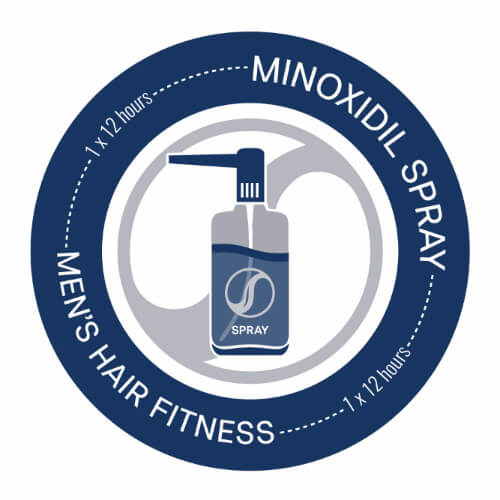Your risk of hair-loss is written in your genes
It’s all about the genetics
Like with so much of your biology, whether or not you are at risk of androgenic alopecia (aka male pattern hair loss) is written your genes. Studies of twins1 show that more than 80% of the variance in both early and late-onset male pattern hair loss can be attributed to genetic factors.
Over the last two decades, the enormous strides made in decoding the human genome have shed considerable light on the root causes of hair loss in men. Recent research points towards two distinct pathways for inheriting hair-loss, which should lead to novel tailored treatments in the future. The complex genetics behind male hair-loss explain why it is so widespread but with safe proven treatments available what's written in your genes doesn’t have to be your destiny.
Look to your Mother's Father
An in-depth study looking at the members of 97 families in 2005, showed the strongest genetic determinate of male pattern hair loss is a mutation of the Androgenic Receptor (AR) gene2. This gene is on your X Chromosome, which, I’m sorry to say it gentlemen, can only come from your good old mum.
Women carry two copies of the X Chromosome, one each from their mother and father. Thus, they can carry the faulty AR gene but because they have a backup copy (and the gene is recessive), not experience significant hair thinning themselves3. However, as they only pass down one X chromosome to their sons you have a 50:50 chance of inheriting your maternal grandfather's thinning hair.
But that doesn’t explain the resemblance between fathers and sons
It has been noted in studies of male pattern hair-loss4 the 1900’s, that there is a very strong resemblance between the time of onset and pattern of hair loss between fathers and sons. Men whose fathers experience hair loss have a two and a half times higher risk5 of developing androgenic alopecia (male pattern hair loss) than those that do not, even after adjusting for age. As you can only inherit the faulty AR gene from your mother, something else must be going on in at least some of the cases.
Two genetic studies in 2008 6 point towards another area (but not yet a specific gene or set of genes) in chromosome 20, which appears to be involved with hair-loss. As you inherit a copy of chromosome 20 from both your father and your mother, this looks like the way good old dad is raining on your parade.
So your Mother is off the hook
In summary, you can inherit your thinning hair from either (or both) your mother and your father via two distinctly different sets of genes in completely different chromosomes. If your maternal grandfather is thinning, there is a very strong risk your mother passed down a faulty copy of the AR genes in your X chromosome. However, if your dad is thin on top, unfortunately, it’s at least a coin flip you inherit it from him as well via a completely different mechanism. With that in mind, it’s not surprising over half of New Zealand men will suffer from some degree of hair loss by the time they are 50.
The good news is your hair is in your hands
The good news is that bad genetics and a touch of fate isn't where the buck stops when it comes to your hair. If you start early enough and stick with one of the proven treatment regimes, you have a very good shot at keeping your hair fit and healthy even with faulty genetics. At Hair Fitness, we are developing a range of convenient and cost effective programs based on clinically proven treatments. If you would like to learn more please subscribe to our blog.
- Nyholt DR, Gillespie NA, Heath AC, Martin NG. Genetic Basis of Male Pattern Baldness. Journal of Investigative Dermatology. 2003;121(6):1561–4. ↩
- Hillmer A M, Hanneken S et al: Genetic Variation in the Human Androgen Receptor Gene Is the Major Determinant of Common Early-Onset Androgenetic Alopecia - American Journal of Human Genetics 2005;77:140–148 ↩
- This is a rather simplistic explanation as it ignores the effects of Testosterone, please see the blog post on the role of DHT in hair-loss for a more in-depth discussion. ↩
- Chumlea C W, Rhodes T, Girman C J et al: Family History and Risk of Hair Loss - Dermatology 2004;209:33-39.↩
- Osborn D: Inheritance of baldness. J Hered 7:347^355, 1916 ↩
- Hillmer A M, Brockschmidt F F et al: Susceptibility variants for male-pattern baldness on chromosome 20p11 - Nature Genetics 2008; 1279-1281 and Richards B J, Yuan X et al: Male-pattern baldness susceptibility locus at 20p11 - Nature Genetics 2008; 1282-1284. ↩
Also in Research & News

Saw Palmetto - a natural way to reduce DHT
An alternative for Men who want to explore a more natural way of blocking DHT is Saw Palmetto. Widely used in the treatment of enlarged prostates, a condition closely hormonally linked to hair loss, there is good scientific evidence that it significantly reduces free DHT and thus protects your hair.
Learn how Saw Palmetto acts to reduce thinning by disrupting the production of DHT. This can have a powerful impact on its own or it can be used to enhance the effect of other treatments as part of a combined program.

What to expect from minoxidil treatment
In the short-term Minoxidil will halt further loss in 95% of men after 3 months of a twice-daily routine. Over a few months, 60% of men will report significant regrowth, especially for those that act quickly to stop the loss. After a year of continuous use, you should expect the initial gains to stabilize as you hair bounces back and you get the thinning under control.The key to using minoxidil is to get into and stick with a healthy routine to get on top of your hair and maintain your gains.

How to sell snake oil
The value of the global hair-loss treatment market is a $2.7bn USD in 2017, which is not surprising when you consider how widespread male pattern hair loss is. Unfortunately, a market that largely attracts not only serious research and clinically proven products, but also a host of more dubious “treatments” and, in some cases, completely unscrupulous “cures”. These can range from the seemingly well-intended but ineffective treatments to outright frauds.
